From Cuba with Color: Famous Painters and Their Contribution
Cuba, an island nation teeming with vibrant culture and rich history, stands as a beacon of artistic excellence in the Caribbean. Its unique cultural heritage, a melting pot of indigenous, African, European, and American influences, has given rise to a distinctive form of art that is both deeply rooted and dynamically contemporary. Cuban art, with its kaleidoscopic colors, bold experimentation, and profound social commentary, reflects the island's complex past and its people's indomitable spirit.
The island's tumultuous history, marked by colonial oppression, the fight for independence, and the complexities of post-revolutionary society, has fueled a deep well of inspiration for artists seeking to capture the essence of Cuban identity. The evolution of Cuban art can be traced through various important movements, each marking a significant period of cultural and political change... From the early colonial period, which introduced European artistic traditions, to the emergence of the Vanguardia artists in the early 20th century, who sought to define a national identity through their work, Cuban art has always been deeply intertwined with the nation's tumultuous history. The Vanguardia movement, in particular, was pivotal in blending traditional and modern elements, setting the stage for future generations of artists to explore and express their reality without constraints!
Among the pantheon of Cuban art, the figure of Wifredo Lam looms large. His revolutionary work, which merged Surrealism and Cubism with Afro-Cuban motifs, opened new avenues for exploration and established a visual language that resonates with the essence of Cuban identity. Following in his footsteps, artists like Amelia Peláez, Carlos Enríquez, and René Portocarrero further enriched the nation's artistic legacy, each contributing their unique voice and vision to the tapestry of Cuban culture.
Today, Cuban art continues to evolve, with contemporary artists exploring new mediums and themes while remaining connected to their rich heritage. In this article we will introduce you to some of the most famous painters of Cuba, whose artistic expressions are deeply intertwined with the island's vibrant culture, complex history, and diverse influences.
1. Fidelio Ponce de León (1895–1949)
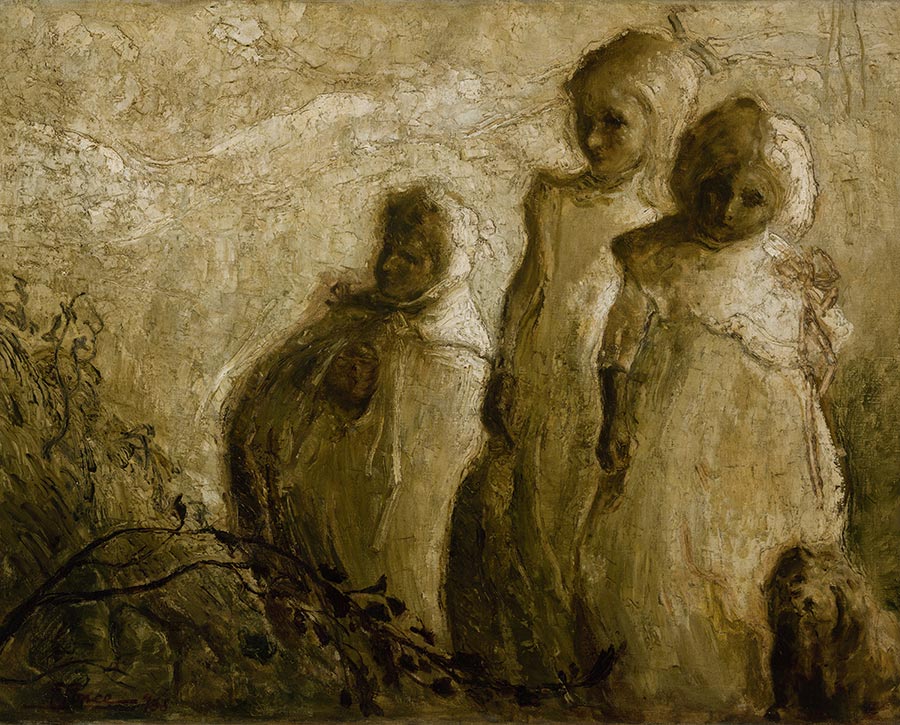
Fidelio Ponce, Niños, 1938
Fidelio Ponce de León stands as a seminal figure in Cuban art, known for his ethereal and introspective paintings that delve into themes of human suffering, spirituality, and existential angst. Despite facing personal hardships, including poor health and poverty, Ponce de León's artistic vision was unwavering, leading to a body of work that is deeply emotional and hauntingly beautiful. He explores issues like poverty, disease, and the human condition in a way that is well complemented by his unique use of light and shadow and a palette that frequently leans toward melancholy tones. Among his most famous works are "La Niña Marta" and "San Francisco de Asís," which exemplify his ability to convey profound spiritual and emotional depth. His unique style, while drawing comparisons to European expressionism, remains deeply rooted in Cuban sensibility, reflecting the complexities of Cuban society during his lifetime. Ponce de León's popularity stems not only from his technical prowess but also from his capacity to evoke a sense of empathy and contemplation among viewers.
2. Amelia Peláez (1896–1968)

Amelia Peláez
Amelia Peláez was a pioneering Cuban painter and ceramist whose work played a crucial role in the development of modern Cuban art. Peláez is celebrated for her vibrant, colorful compositions that blend elements of Cubism with the rich visual heritage of Cuba. Her paintings often feature bold outlines and bright colors, drawing inspiration from the island's tropical landscape, its architecture, and its decorative arts. Peláez studied at the San Alejandro Academy in Havana and further honed her skills in Paris, where she was exposed to the works of European modernists like Pablo Picasso and Henri Matisse. This European influence, combined with her deep affection for Cuban cultural motifs, especially the ornate style of Spanish colonial architecture, informed her unique artistic language. Among her most famous works are her dynamic still lifes and interiors, which are characterized by their strong use of color and form, and their incorporation of traditional Cuban elements, such as stained-glass windows, ceramics, and textiles. In "El Jarro", through bold outlines and a palette of vivid colors, Peláez transforms a simple pitcher into a representation of Cuban domestic life, imbuing it with a sense of national identity and pride. "Ventana", another of Peláez's celebrated works, beautifully encapsulates the essence of Cuban architecture and its lush surroundings. The painting skillfully combines architectural precision with the organic forms of nature, featuring a stained glass window that serves as a focal point against a backdrop of vibrant foliage.
3. Carlos Enríquez (1900–1957)

Carlos Enríquez "La Gitana Tropical"
Carlos Enríquez, well-known for his contributions to contemporary Cuban art, was a key member of the Vanguardia movement in Cuba. Enríquez was deeply influenced by his experiences in Europe, particularly in Paris, where he absorbed elements of Surrealism and Cubism. Enríquez's art is celebrated for its bold exploration of Cuban identity, sexuality, and folklore, often interwoven with themes of social injustice and political commentary. His paintings are characterized by their dynamic compositions, vibrant colors, and the integration of human and animal figures, creating deeply symbolic and often provocative narratives. Among his most famous works are "La Gitana Tropical", which depicts a sensuous, mythic representation of Cuban womanhood, and "El Rapto de las Mulatas", a striking commentary on racial and social dynamics in Cuba. These works, among others, have cemented Enríquez's reputation as a master storyteller and a critical observer of Cuban society. Enríquez's popularity stems not only from his technical skill but also from his courage to address complex and often controversial subjects through his art.
4. Wifredo Lam (1902–1982)
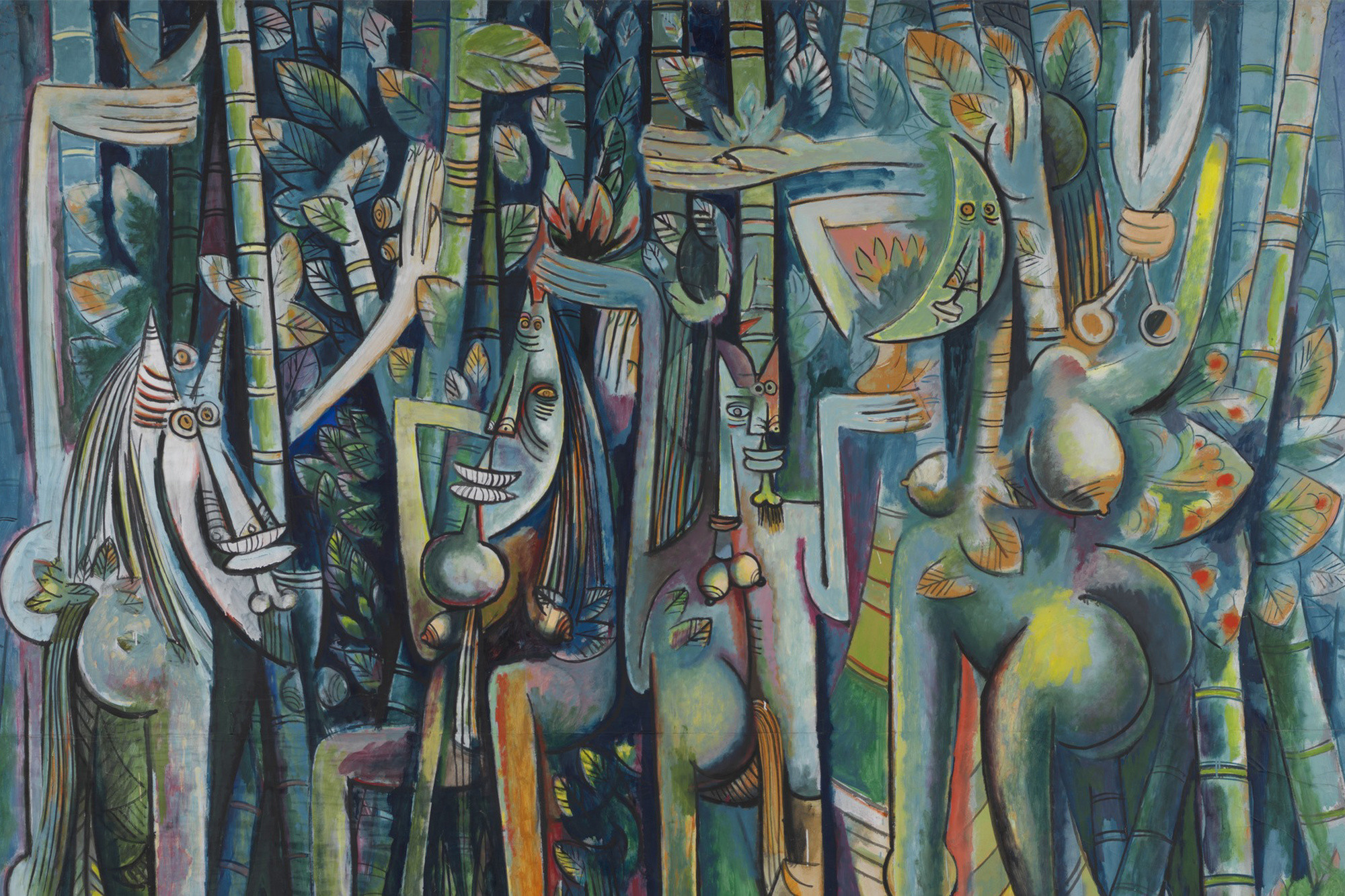
Wifredo Lam "The Jungle" 1943
Wifredo Lam, who emerged as one of the most iconic figures in the 20th-century art world, known for his unique blend of Surrealism, Cubism, and African influences. Born in Sagua La Grande, Cuba, to a Chinese father and a mother of African and Spanish descent, Lam's multicultural heritage deeply influenced his artistic vision, enabling him to create a body of work that transcended traditional boundaries and explored themes of spirituality, identity, and colonialism. Lam's journey as an artist took him from Havana to Madrid, where he studied under Fernando Álvarez de Sotomayor, the director of the Museo del Prado and a teacher of Salvador Dali. His travels to Paris introduced him to the works of Picasso, who became a friend and mentor, significantly impacting Lam's artistic development. His experiences in Europe, combined with his return to Cuba in the 1940s, fueled his commitment to addressing issues of social injustice and the legacy of slavery in his homeland. One of Lam's most celebrated works is "The Jungle" (La Jungla), which is widely regarded as his masterpiece. This large mural-sized painting blends human, animal, and vegetal forms into a dense, jungle-like composition that reflects the artist's critical perspective on colonial exploitation and the synthesis of his Afro-Cuban identity. The figures in "The Jungle," with their elongated limbs and hybrid forms, evoke the spiritual world of Santería, a syncretic religion practiced in Cuba, while also drawing on the visual language of European modernism. Lam's work is celebrated for its innovative approach to form and content, challenging traditional notions of race, culture, and colonialism.
5. René Portocarrero (1912–1985)
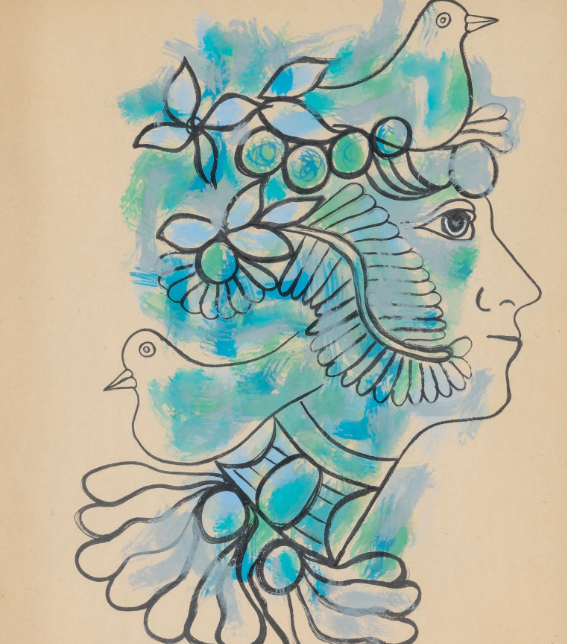
René Portocarrero "Floras" 1977
René Portocarrero was a distinguished Cuban painter and ceramist, celebrated for his vibrant, expressive works that are deeply rooted in Cuban culture and landscapes. Portocarrero developed a style that was both unique and instantly recognizable, characterized by a riot of color, intricate patterns, and dynamic, almost surreal forms. His work often depicted themes drawn from his surroundings, including the baroque architecture of Havana, the vitality of Cuban festivals, and the lushness of the island's natural environment. Portocarrero's art is noted for its abstract and fantastical elements, blending the real with the imaginary to create compositions that are rich in symbolism and emotion. Among his most famous works are his series of "Ciudadelas" (Citadels) and "Floras," which showcase his ability to merge the architectural with the organic. Unlike the more politically charged works of some of his contemporaries, Portocarrero's paintings exude a sense of joy and celebration, capturing the essence of Cuban spirit and identity.
6. Mario Carreño (1913–1999)

Mario Carreño
Mario Carreño was a prominent Cuban painter whose work spans a remarkable range of styles and themes, reflecting the diverse influences and experiences of his life and career. Carreño was a versatile artist who initially embraced and then moved beyond the classical training he received, exploring and contributing to various movements over the decades, including Surrealism, Social Realism, and Abstract Expressionism. Carreño's early work was heavily influenced by his studies in Spain and France, where he was exposed to the avant-garde movements of Europe. His paintings from this period often depict the human form in a stylized, geometric manner, incorporating elements of Cubism and Surrealism. However, it was his return to the Caribbean and his immersion in the vibrant culture and tropical landscape of Cuba that deeply influenced his palette, infusing his work with bright colors and dynamic forms. Among his most celebrated works are the murals he created in the 1940s, which showcase his commitment to integrating art with public spaces, and his series of abstract compositions from the 1950s and beyond, which reflect his ongoing exploration of form, color, and texture. Carreño's "Cocina Monstruo" (Monster Kitchen) is particularly notable for its inventive use of color and shape to create a composition that is at once abstract and deeply evocative of Cuban themes. Carreño's popularity and significance in the art world are due to his ability to synthesize diverse artistic languages and influences into a coherent and compelling body of work that speaks to both universal themes and specific cultural contexts. His mastery of different styles and techniques, along with his innovative approach to composition and color, have earned him a place among the most important Latin American artists of the 20th century.
7. Tomás Sánchez (1948)
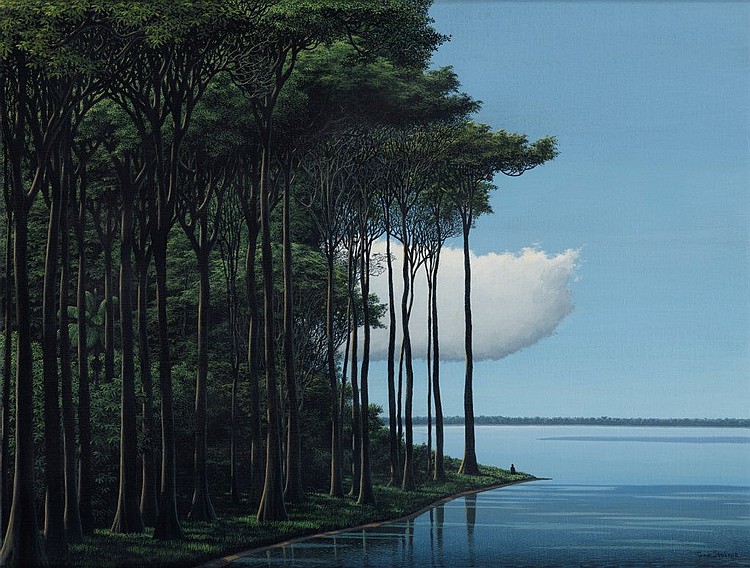
Tomás Sánchez "Lago" 1977
Tomás Sánchez is one of Cuba's most acclaimed contemporary artists, celebrated for his meticulously detailed landscapes that invite viewers into serene, idealized visions of nature. Sánchez's paintings are distinguished by their hyper-realistic portrayals of serene landscapes, such as immaculate lakes, deep forests, and serene waterfalls, that are frequently devoid of people, implying a return to an unspoiled, primeval world.
One of his most iconic series is the "Lago" series, where the stillness of water and the lushness of the surrounding foliage create a sense of profound calm and reflection. Similarly, his "Vistas" series presents panoramic views of unspoiled nature, emphasizing the vastness and beauty of the natural world. In a world often marked by chaos and disruption, Sánchez's paintings offer a sanctuary, a place where one can momentarily escape and reconnect with the elemental forces of nature... Throughout his career, Sánchez has been recognized with numerous awards and his works have been exhibited in galleries and museums worldwide.
8. Roberto Fabelo (1951)
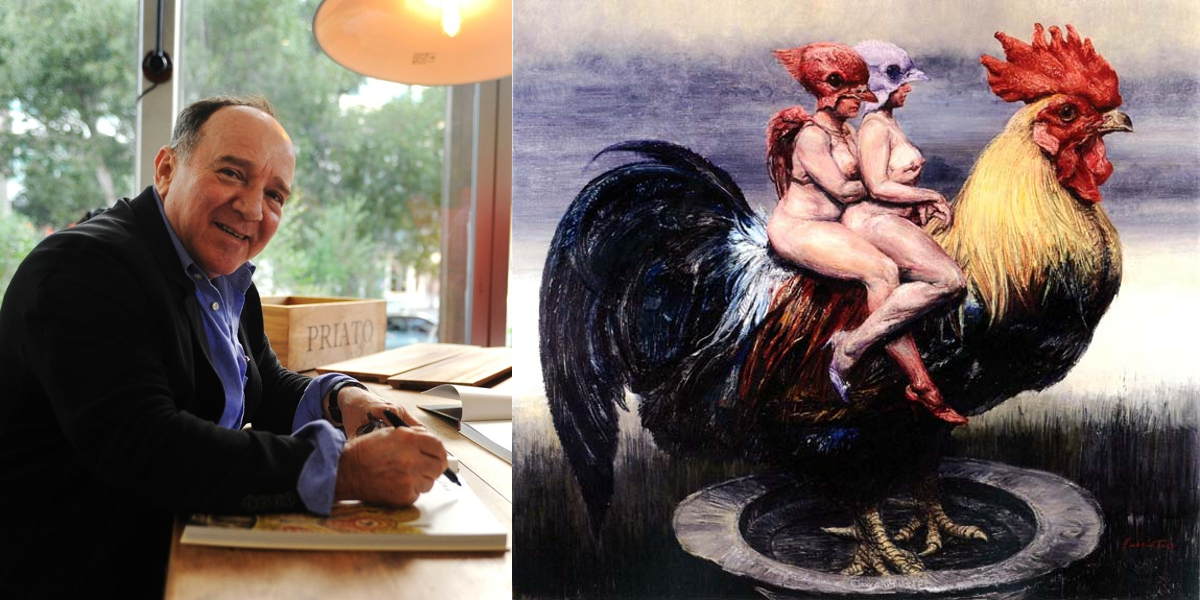
Roberto Fabelo is a contemporary Cuban artist renowned for his versatility across various mediums, including painting, drawing, sculpture, and installation. Fabelo's artistry emerges from the vibrant heritage of Cuban artistic expression, setting itself apart with a distinctive fusion of surrealistic flair, fantastical elements, and insightful societal reflections. His creations frequently feature an array of mythical beings, human forms in surprising arrangements, and motifs from both the tangible landscape and fantastical realms, crafting narratives that are simultaneously whimsical and thought-provoking. Large-scale sculptures and installations that have been shown in public areas are some of his most well-known pieces. One such piece is "Sobrevivientes," which has giant human figures with rooster heads as a sign of resiliency and the complexity of human nature. Fabelo's works are popular not only for their visual appeal but also for their capacity to engage with societal issues and human emotions in a way that is both accessible and deeply reflective. Fabelo continues to inspire with his imaginative vision, making significant contributions to the dialogue of contemporary art both within Cuba and internationally.
From Tradition to Modernity with TrendGallery
From the avant-garde ideas of Amelia Peláez and Wifredo Lam to the cutting-edge perspectives of Roberto Fabelo and Tomás Sánchez, Cuba's diverse range of artists demonstrates a dynamic heritage of creative expression and inventive artistry. These artists encourage us to delve into the depths of Cuban identity and creativity with their distinctive fusion of heritage, invention, and reflection. Which features of Cuban art appeal to you the most, and how do you think these creative expressions are affecting the international art scene? And do not forget, whether you're interested in modern abstract pieces, traditional paintings, or innovative sculptures, TrendGallery can be an excellent resource for expanding your artistic horizons and finding inspiration.
No Comments Yet...